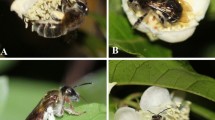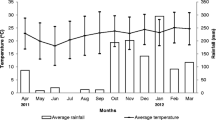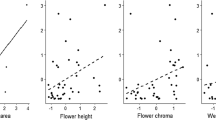Abstract
In this study, the daily and seasonal influences of abiotic factors and the amount of floral resources on the foraging frequency of bees were determined. The experiments were performed, during 12 consecutive months, in the main floral sources used by bees in a secondary forest fragment. The foraging frequency of each bee species on flowers of each plant was recorded for 20-min periods, every hour. To verify whether the foraging activity is influenced by abiotic factors, Pearson’s correlation analysis and linear regression tests were performed for the dominant bee species. Temperature and luminosity were the two main abiotic factors regulating foraging activities of bees. A positive correlation was found between the foraging frequency of most bees and these two variables. Conversely, the foraging activity was influenced neither by the relative humidity nor by the wind speed. The activity of each species depends on a combination of factors that include not only abiotic variables, but also the amount of floral resources available during the day, body size, and behavior of each visitor. After a certain period of the day, the scarcity of floral resources produced by most plants can stimulate the bees to forage in the flowers early in subsequent days, which may occur before the period in which the abiotic conditions are really favorable.


Similar content being viewed by others
References
Almeida-Soares S, Polatto LP, Dutra JCS, Torezan-Silingardi HM (2010) Pollination of Adenocalymma Bracteatum (Bignoniaceae) :Floral Biology and Visitors. Neotrop Entomol 39:941–948
Antonini Y, Souza HG, Jacobi CM, Mury FB (2005) Diversidade e Comportamento dos Insetos Visitantes Florais de Stachytarpheta Glabra Cham. (Verbenaceae), em uma Área de Campo Ferruginoso, Ouro Preto, MG. Neotrop Entomol 34:555–564
Ayres M, Ayres-Jr M, Ayres DL, Santos AAS (2007) BioEstat: aplicações estatísticas nas áreas das ciências bio-médicas. Sociedade Civil Mamirauá, MCT-CNPq, Belém
Bartholomew GA, Heinrich B (1973) A Field Study of Flight Temperatures in Moths in Relation to Body Weight and Wing Loading. J Exp Biol 58:123–135
Bartholomew GA, Heinrich B (1978) Endothermy in African Dung Beetles During Flight, Ball Making, and Ball Rolling. J Exp Biol 73:65–83
Biesmeijer JC, Vries H (2001) Exploration and Exploitation of Food Sources by Social Insect Colonies: A Revision of the Scout-Recruit Concept. Behav Ecol Sociobiol 49:89–99
Biesmeijer JC, Born M, Lukács S, Sommeijer MJ (1999) The Response of the Stingless bee Melipona Beecheii to Experimental Pollen Stress, Worker Loss and Different Levels of Information Input. J Apic Res 38:33–41
Bishop JA, Armbruster WS (1999) Thermoregulatory Abilities of Alaskan Bees: Effects of Size, Phylogeny and Ecology. Funct Ecol 13:711–724
Brizola-Bonacina AK, Arruda VM, Alves-Junior VV, Chaud-Netto J, Polatto LP (2012) Bee Visitors of Quaresmeira Flowers (Tibouchina Granulosa Cogn.) in the Region of Dourados (MS-Brasil). Sociobiology 59:1–15
Cane JH (2001) Habitat fragmentation and native bees: a premature verdict? Cons Ecol 5: 3. Available at <http://www.ecologyandsociety.org/vol5/iss1/art3/>. Accessed 23 Jan 2012
Cena K, Clark JA (1972) Effect of Solar Radiation on Temperatures of Working Honey Bees. Nature 236:222–223
Coelho JR (1991) The Effect of Thorax Temperature on Force Production During Tethered Flight in Honeybee (Apis Mellifera) Drones, Workers, and Queens. Physiol Zool 64:823–835
Coelho JR, Ross AJ (1996) Body Temperature and Thermoregulation in two Species of Yellowjackets Vespula Germanica and V Maculifrons. J Comp Physiol B Biochem Syst Environ Physiol 166:68–76
Cooper PD, Schaffer WM, Buchmann SL (1985) Temperature Regulation of Honey Bees (Apis Mellifera) Foraging in the Sonoran Desert. J Exp Biol 114:1–15
Corbet SA, Fussel M, Ake R, Fraser A, Gunson C, Savage A, Smith K (1993) Temperature and Pollination Activity of Social Bees. Ecol Entomol 18:17–30
Dudley R (2000) The Biomechanics of Insect Flight. Princeton University Press, Princeton
Dzialowski EM (2005) Use of Operative Temperature and Standard Operative Temperature Models in Thermal Biology. J Therm Biol 30:317–334
Engel MS, Dingemans-Bakels F (1980) Nectar and Pollen Resources for Stingless Bees (Meliponinae, Hymenoptera) in Surinam (South America). Apidologie 11:341–350
Engels W, Engels E (1980) Experiments With Caged and Free-Flying Scaptotrigona Postica in South America and Europe, With Special Reference to the Question of Food Resource Competition Between Stingless Bees and Honeybees. Insectes Soc 27:280–281
Fewell JH, Winston ML (1992) Colony State and Regulation of Pollen Foraging in the Honey-bee, Apis Mellifera L. Behav Ecol Sociobiol 30:387–393
Fewell JH, Winston ML (1996) Regulation of Nectar Collection in Relation to Honey Storage Levels by Honey Bees, Apis Mellifera. Behav Ecol 7:286–291
Fidalgo AO, Kleinert AMP (2007) Foraging Behavior of Melipona Rufiventris Lepeletier (Apinae, Meliponini) in Ubatuba/SP, Brazil. Braz J Biol 67:137–144
Grüter G, Farina WM (2007) Nectar Distribution and its Relation to Food Quality in Honeybee (Apis Mellifera) Colonies. Insectes Soc 54:87–94
Hartfelder K, Bitondi MMG, Brent CS, Guidugli-Lazzarini KR, Simões ZLP, Stabentheiner A, Tanaka ÉD, Wang Y (2013) Standard methods for physiology and biochemistry research in Apis mellifera. In: Dietemann V, Ellis JD, Neumann P (eds) The coloss beebook, vol. I: standard methods for Apis mellifera research. J Apic Res 52: 26–31.
Heinrich B (1972) Energetics of Temperature Regulation and Foraging in a Bumblebee, Bombus Terricola Kirby. J Comp Physiol 77:49–64
Heinrich B (1974) Thermoregulation in Bumblebees II Energetics of Warm-up and Free Flight. J Comp Physiol 96:155–166
Heinrich B (1979a) Thermoregulation of African and European Honeybees During Foraging, Attack, and Hive Exits and Returns. J Exp Biol 80:217–229
Heinrich B (1979b) Keeping a Cool Head: Honeybee Thermoregulation. Science 205:1269–1271
Heinrich B (1980) Mechanisms of Body-Temperature Regulation in Honey Bees Apis Mellifera II Regulation of Thoracic Temperature at High air Temperatures. J Exp Biol 85:73–87
Heinrich B (1984) Strategies of Thermoregulation and Foraging in two Vespid Wasps, Dolichovespula Maculata and Vespula Vulgaris. J Comp Physiol 154:175–180
Heinrich B, Esch A (1994) Bees Regulate Their Body Temperature by Means of Behavior, Morphology and Physiology, Which Helps Them to Meet Individual and Social Needs. Am Sci 82:164–170
Heinrich B, Heinrich MJE (1983) Size and Caste in Temperature Regulation by Bumblebees. Physiol Zool 56:552–562
Heinrich B, Raven PH (1972) Energetics and Pollination Ecology. Science 176:597–602
Hilário SD, Imperatriz-Fonseca VL, Kleinert AMP (2000) Flight Activity and Colony Strength in the Stingless bee Melipona Bicolor Bicolor (Apidae, Meliponinae). Rev Bras Biol 60:299–306
Hofstede FE, Sommeijer MJ (2006) Influence of Environmental and Colony Factors on the Initial Commodity Choice of Foragers of the Stingless bee Plebeia Tobagoensis (Hymenoptera, Meliponini). Insectes Soc 53:258–264
Instituto Nacional de Meteorologia (2011) Clima: normais climáticas. Available at <http://www.inmet.gov.br/html/clima.php#>. Accessed 29 Nov 2011
Kaps M, Lamberson WR (2004) Biostatistics for Animal Science. CABI, Wallingford
Kasper ML, Reeson AF, Mackay DA, Austin AD (2008) Environmental Factors Influencing Daily Foraging Activity of Vespula Germanica (Hymenoptera, Vespidae) in Mediterranean Australia. Insectes Soc 55:288–295
Kleinert AMP, Ramalho M, Cortopassi-Laurino M, Ribeiro MF, Imperatriz-Fonseca VL (2009) Abelhas Sociais (Bombini, Apini, Meliponini). In: Panizzi AR, Parra JRP (eds) Bioecologia e Nutrição de Insetos: Base Para o Manejo Integrado de Pragas. Embrapa Informação Tecnológica, Brasília, pp 371–424
Kleinert-Giovannini A (1982) The Influence of Climatic Factors on Flight Activity of Plebeia Emerina Friese (Hymenoptera, Apidae, Meliponinae) in Winter. Rev Bras Entomol 26:1–13
Kleinert-Giovannini A, Imperatriz-Fonseca VL (1986) Flight Activity and Climatic Conditions: Responses by two Subspecies of Melipona Marginata Lepeletier (Apidae, Meliponinae). J Apic Res 25:3–8
Kovac H, Schmaranzer S (1996) Thermoregulation of Honeybees (Apis Mellifera) Foraging in Spring and Summer at Different Plants. J Insect Physiol 42:1071–1076
Kovac H, Stabentheiner A (2011) Thermoregulation of Foraging Honeybees on Flowering Plants: Seasonal Variability and Influence of Radiative Heat Gain. Ecol Entomol 36:686–699
Kovac H, Stabentheiner A, Schmaranzer S (2009) Thermoregulation of Water Foraging Wasps (Vespula Vulgaris and Polistes Dominulus). J Insect Physiol 55:959–966
Kovac H, Stabentheiner A, Schmaranzer S (2010) Thermoregulation of Water Foraging Honeybees: Balancing of Endothermic Activity With Radiative Heat Gain and Functional Requirements. J Insect Physiol 56:1834–1845
Laroca S, Cure JR, Bortoli C (1982) A Associação das Abelhas Silvestres (Hymenoptera, Apoidea) de uma Área Restrita no Interior da Cidade de Curitiba (Brasil): uma Abordagem Biocenótica. Dusenia 13:93–117
Mapalad KS, Leu D, Nieh JC (2008) Bumble Bees Heat up for High Quality Pollen. J Exp Biol 211:2239–2242
Michener CD (2007) The Bees of the World, 2nd edn. The Johns Hopkins University Press, Baltimore
Morato EF, Campos LAO (2000) Partição de Recursos Florais de Espécies de Sida Linnaeus e Mauvastrum Coromandelianum (Linnaeus) Garck (Malvaceae) Entre Cephalurgus Anomalus Moure & Oliveira (Hymenoptera, Andrenidae, Panurginae) e Melissoptila Cnecomala (Moure) (Hymenoptera, Apidae, Eucerini). Rev Bras Zool 17:705–727
Morellato LPC, Leitão Filho HF, Rodrigues RR, Joly CA (1990) Estratégias Fenológicas de Espécies Arbóreas em Floresta de Altitude na Serra do Japi, Jundiaí São Paulo. Rev Bras Biol 50:149–162
Moure JS, Melo GAR, Urban D (2012) Catalogue of bees (Hymenoptera, Apoidea) in the neotropical region online version. Available at <http://www.moure.cria.org.br/catalogue>. Accessed 13 Jan 2012
Nieh JC, Sánchez D (2005) Effect of Food Quality, Distance and Height on Thoracic Temperature in the Stingless bee Melipona Panamica. J Exp Biol 208:3933–3943
Nieh JC, León A, Cameron S, Vandame R (2006) Hot Bumble Bees at Good Food: Thoracic Temperature of Feeding Bombus Wilmattae Foragers is Tuned to Sugar Concentration. J Exp Biol 209:4185–4192
Nuñez JA (2000) Foraging efficiency and survival of African honeybees in the tropics. In Encontro Sobre Abelhas, 4., 2000. Ribeirão Preto, Anais… Ribeirão Preto: [s.n.], pp. 9–16
Polatto LP, Alves-Jr VV (2008) Utilização dos Recursos Florais Pelos Visitantes em Sparattosperma Leucanthum (Vell.) K. Schum. (Bignoniaceae). Neotrop Entomol 37:389–398
Polatto LP, Dutra JCS, Alves Junior VV (2007) Biologia Reprodutiva de Pyrostegia Venusta (Ker-Gawl) Miers (Bignoniaceae) e Comportamento de Forrageamento dos Visitantes Florais Predominantes. Rev Biol Neotrop 4:46–57
Polatto LP, Chaud-Netto J, Dutra JCS, Alves Junior VV (2012) Exploitation of Floral Resources on Sparattosperma Leucanthum (Bignoniaceae): Foraging Activity of the Pollinators and the Nectar and Pollen Thieves. Acta Ethologica 15:119–126
Ramalho M, Imperatriz-Fonseca VL, Kleinert-Giovannini A (1991) Ecologia Nutricional de Abelhas Sociais. In: Panizzi AR, Parra JRP (eds) Ecologia Nutricional de Insetos e Suas Implicações no Manejo de Pragas. Manole, Barueri, pp 225–252
Ramalho M, Giannini TC, Malagodi-Braga KS, Imperatriz-Fonseca VL (1994) Pollen Harvest by Stingless bee Foragers (Hymenoptera, Apidae, Meliponinae). Grana 33:239–244
Ramalho M, Imperatriz-Fonseca VL, Giannini TC (1998) Within Colony-Size Variation of Foragers and Pollen Load Capacity in the Stingless bee Melipona Quadrifasciata Anthidioides Lepeletier (Apidae, Hymenoptera). Apidologie 29:221–228
Roberts SP, Harrison JF (1998) Mechanisms of Thermoregulation in Flying Bees. Am Zool 38:492–502
Roberts SP, Harrison JF (1999) Mechanisms of Thermal Stability During Flight in the Honeybee Apis Mellifera. J Exp Biol 202:1523–1533
Roubik DW (1989) Ecology and Natural History of Tropical Bees. Cambridge University Press, New York
Sadler N, Nieh JC (2011) Honey bee Forager Thoracic Temperature Inside the Nest is Tuned to Broad-Scale Differences in Recruitment Motivation. J Exp Biol 214:469–475
Sakagami SF, Laroca S, Moure JS (1967) Wild bee Biocenotics in São José dos Pinhais (PR), South Brazil: Preliminary Report. J Fac Sci Hokkaido Univ Ser VI Zool 16:253–291
Schmaranzer S (2000) Thermoregulation of Water Collecting Honey Bees (Apis Mellifera). J Insect Physiol 46:1187–1194
Schuster A, Noy-Meir I, Heyn CC, Dafni A (1993) Pollination-Dependent Female Reproductive Success in a Self-Compatible Outcrosser, Asphodelus Aestivus Brot. New Phytol 123:165–174
Seeley TD (1995) The Wisdom of the Hive: the Social Physiology of Honey bee Colonies. Harvard University Press, Cambridge
Silveira-Neto S, Nakano O, Barbin D, Villa-Nova NA (1976) Manual de Ecologia dos Insetos. Agronômica Ceres, São Paulo
Sommeijer MJ, Derooy GA, Punt W, Bruijn LLM (1983) A Comparative Study of Foraging Behavior and Pollen Resource of Various Stingless Bees (Hym., Meliponinae) and Honey Bees (Hym., Apinae) in Trinidad, West-Indies. Apidologie 14:205–224
Stabentheiner A (2001) Thermoregulation of Dancing Bees: Thoracic Temperature of Pollen and Nectar Foragers in Relation to Profitability of Foraging and Colony Need. J Insect Physiol 47:385–392
Stone GN (1993) Endothermy in the Solitary bee Anthophora Plumipes: Independent Measures of Thermoregulatory Ability, Costs of Warm-up and the Role of Body Size. J Exp Biol 174:299–320
Stone GN (1994) Activity Patterns of Females of the Solitary bee Anthophora Plumipes in Relation to Temperature, Nectar Supplies and Body-Size. Ecol Entomol 19:177–189
Stone GN, Willmer PG (1989a) Endothermy and Temperature Regulation in Bees: a Critique of ‘grab and stab’ Measurement of Body Temperature. J Exp Biol 143:211–223
Stone GN, Willmer PG (1989b) Warm-up Rates and Body Temperatures in Bees: the Importance of Body Size, Thermal Regime and Phylogeny. J Exp Biol 147:303–328
Szabo TI (1980) Effect of Weather Factors on Honey-bee Flight Activity and Colony Weight-Gain. J Apic Res 19:164–171
Underwood B (1991) Thermoregulation and Energetic Decision Making by the Honeybees Apis Cerana, Apis Dorsata and Apis Laboriosa. J Exp Biol 157:19–34
Vicens N, Bosch J (2000) Weather-Dependent Pollinator Activity in an Apple Orchard, With Special Reference to Osmia Cornuta and Apis Mellifera (Hymenoptera: Megachilidae and Apidae). Environ Entomol 29:413–420
Waddington KD (1990) Foraging Profits and Thoracic Temperatures of Honey Bees (Apis Mellifera). J Comp Physiol 160:325–329
Waser NM (1983) The Adaptive Nature of Floral Traits: Ideas and Evidence. In: Real L (ed) Pollination Biology. Academic, Orlando, Florida, pp 241–285
Woods-Jr WA, Heinrich B, Stevenson RD (2005) Honeybee Flight Metabolic Rate: Does it Depend Upon air Temperature? J Exp Biol 208:1161–1173
Zavattini JA (1992) Dinâmica Climática no Mato Grosso do Sul. Geografia 17:65–91
Acknowledgments
The authors are grateful to Daniela de Oliveira Dinato and Dr. Júlio Antonio Lombardi who identified the plant species and prepared exsiccates for deposit into the Herbarium of Rio Claro, and also to Dra. Silvia Regina de Menezes Pedro who identified the bee species.
Author information
Authors and Affiliations
Corresponding author
Rights and permissions
About this article
Cite this article
Polatto, L.P., Chaud-Netto, J. & Alves-Junior, V.V. Influence of Abiotic Factors and Floral Resource Availability on Daily Foraging Activity of Bees. J Insect Behav 27, 593–612 (2014). https://doi.org/10.1007/s10905-014-9452-6
Revised:
Accepted:
Published:
Issue Date:
DOI: https://doi.org/10.1007/s10905-014-9452-6




